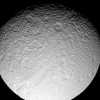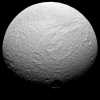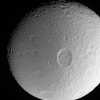Tethys orbits Saturn in an almost perfectly circular orbit with a radius of 294,619 km (183,000 miles), taking 45.3 hours to complete one orbit. It is roughly spherical, about 1,066 km (670 miles) across. Tethys has a number of interesting surface features, the most obvious being Odysseus, a huge crater 400 km (250 miles) across. Features on Tethys are named for characters and places from
The Iliad
and
The Odyssey.
As Tethys comprises principally water ice, the crater has slumped over eons and has lost the ring of mountains around it, and the central peak, typical of impact craters.
Penelope is another large crater with, to its left, three smaller features all about the same size that run north to south, top to bottom in the image of Penelope, below. They are called, from top to bottom, Phemius, Polyphemus and Ajax.
Another large feature is the Ithaca Chasm. It is 2,000 km (1,250 miles) long, 100 km (62miles) wide and 3 to 5 km (2 to 3 miles) deep. As the internal liquid water froze, it would have expanded, and probably cracked the surface that had already frozen over. It is also possible that it is a crack resulting from the impact that caused the Odysseus crater.
In the images to the right, you see the Ithaca Chasm running from the upper right to lower left.
Penelope is another large crater with, to its left, three smaller features all about the same size that run north to south, top to bottom in the image of Penelope, below. They are called, from top to bottom, Phemius, Polyphemus and Ajax.
Another large feature is the Ithaca Chasm. It is 2,000 km (1,250 miles) long, 100 km (62miles) wide and 3 to 5 km (2 to 3 miles) deep. As the internal liquid water froze, it would have expanded, and probably cracked the surface that had already frozen over. It is also possible that it is a crack resulting from the impact that caused the Odysseus crater.
In the images to the right, you see the Ithaca Chasm running from the upper right to lower left.
Tethys
& Its TrojansSolar System -
Saturn's Moons
Calypso
Telesto
Image Credit: NASA/JPL/Space Science Institute (Cassini)
Odysseus Crater
Penelope Crater
Telesto and Calypso, two of Saturn's smaller moons, are in the same orbit as Tethys, but in its L4 and L5 Lagrangian points. They were both first observed in 1980.
Telesto orbits Saturn in Tethys' L4 which is 60º ahead of Tethys. It has an elongated shape with dimensions of 32.6×23.6×20 km, giving an average diameter of 24.8 km.
Calypso orbits in the L5, 60º behind Tethys. It is also elongated in shape, like Telesto, but somewhat smaller at 30.2×23×14 km, giving an average diamter of 21.4 km
Telesto orbits Saturn in Tethys' L4 which is 60º ahead of Tethys. It has an elongated shape with dimensions of 32.6×23.6×20 km, giving an average diameter of 24.8 km.
Calypso orbits in the L5, 60º behind Tethys. It is also elongated in shape, like Telesto, but somewhat smaller at 30.2×23×14 km, giving an average diamter of 21.4 km
Saturn's moons are grouped as follows. Select to see details of the moon or the group of moons:
Mimas • Enceladus • Tethys • Dione • Rhea • Titan • Iapetus • Hyperion • Norse Grp • Shepherd Moons • Alkyonides • Inuit Grp • Gallic Grp • Misc








